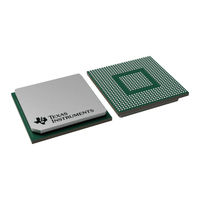Texas Instruments TMS320C6457 Manuals
Manuals and User Guides for Texas Instruments TMS320C6457. We have 4 Texas Instruments TMS320C6457 manuals available for free PDF download: User Manual, Quick Setup Manual
Texas Instruments TMS320C6457 User Manual (79 pages)
DSP Turbo-Decoder Coprocessor 2 (TCP2)
Brand: Texas Instruments
|
Category: Signal Processors
|
Size: 0 MB
Table of Contents
Advertisement
Texas Instruments TMS320C6457 User Manual (43 pages)
DSP Host Port Interface (HPI)
Brand: Texas Instruments
|
Category: Host Adapter
|
Size: 0 MB
Table of Contents
Texas Instruments TMS320C6457 User Manual (19 pages)
DSP Power/Sleep Controller (PSC)
Brand: Texas Instruments
|
Category: Controller
|
Size: 0 MB
Table of Contents
Advertisement
Texas Instruments TMS320C6457 Quick Setup Manual (2 pages)
Lite Evaluation Module
Brand: Texas Instruments
|
Category: Computer Hardware
|
Size: 5 MB
Advertisement
Related Products
- Texas Instruments TMS320C6455
- Texas Instruments TMS320C6454
- Texas Instruments TMS320C645X
- Texas Instruments TMS320C6472
- Texas Instruments TMS320C64x DSP
- Texas Instruments TMS320C6452 DSP
- Texas Instruments TMS320C642x DSP
- Texas Instruments TMS320C6474
- Texas Instruments TMS320C64x+
- Texas Instruments TMS320C642 Series



